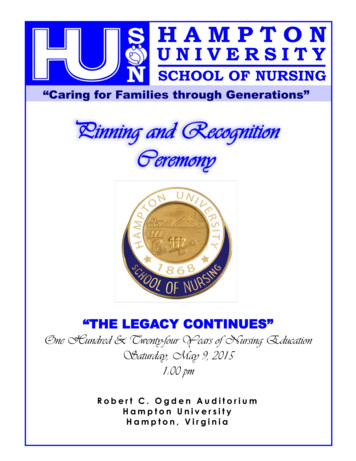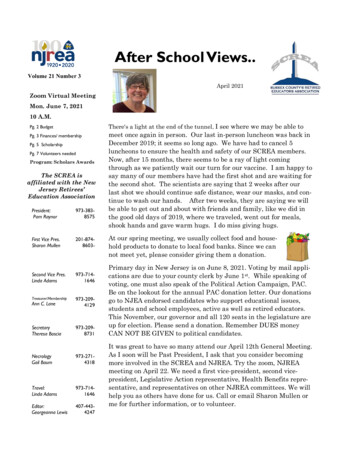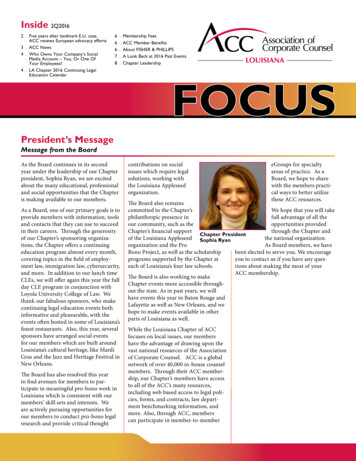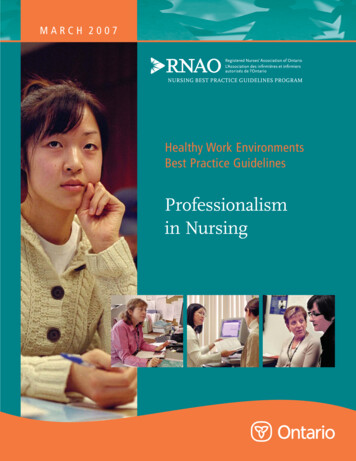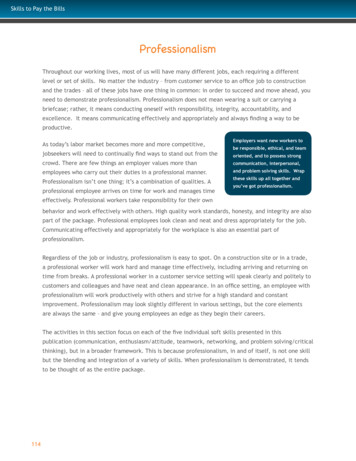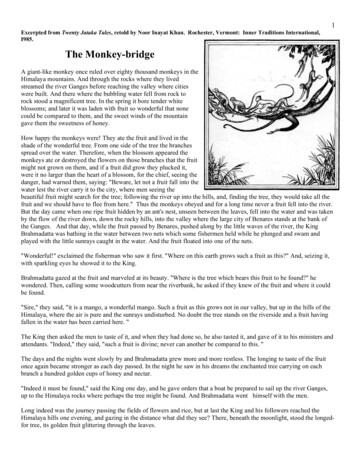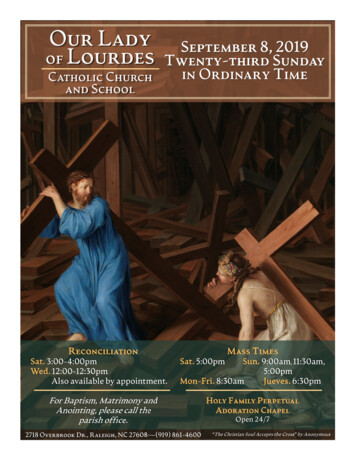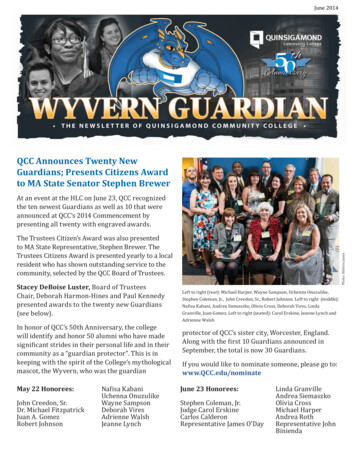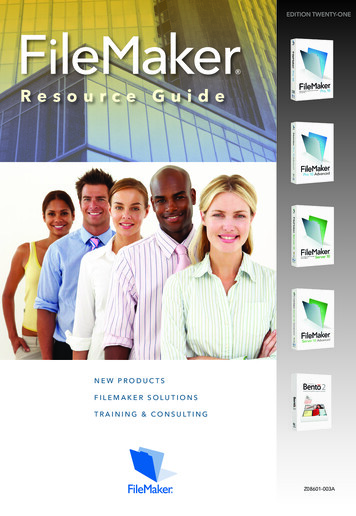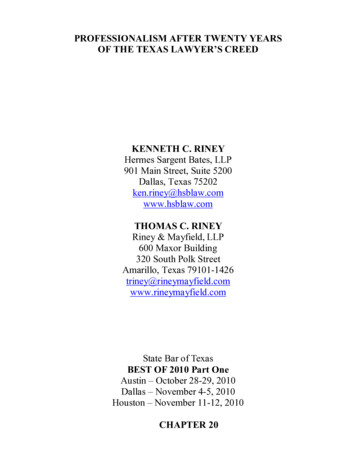
Transcription
PROFESSIONALISM AFTER TWENTY YEARSOF THE TEXAS LAWYER’S CREEDKENNETH C. RINEYHermes Sargent Bates, LLP901 Main Street, Suite 5200Dallas, Texas 75202ken.riney@hsblaw.comwww.hsblaw.comTHOMAS C. RINEYRiney & Mayfield, LLP600 Maxor Building320 South Polk StreetAmarillo, Texas d.comState Bar of TexasBEST OF 2010 Part OneAustin – October 28-29, 2010Dallas – November 4-5, 2010Houston – November 11-12, 2010CHAPTER 20
KENNETH C. RINEYHERMES SARGENT BATES, LLPwww.hsblaw.com901 Main Street, Suite 5200Dallas, TX 75202(214) 749-6541; Fax (214) 749-6341ken.riney@hsblaw.comKenneth C. Riney has practiced civil trial law for over five years. His practice includes general civillitigation, premises liability, products liability, professional liability and commercial litigation. Mr. Rineywas named a “Rising Star” by Texas Monthly and Law & Politics Magazine in 2008 and 2010. In 2009, hereceived the Texas Young Lawyers Association President’s Award of Merit.Ken currently serves on the boards of directors for the Texas Association of Defense Counsel, TexasYoung Lawyers Association and Dallas Association of Young Lawyers. He is a Fellow of the Texas BarFoundation and Life Fellow of the Dallas Association of Young Lawyers Foundation.Ken received his B.S. degree from Texas A&M University in 2001 and his J.D. from South TexasCollege of Law in 2004, where he was selected for inclusion in the Order of Barristers and was awarded theDean’s Student Advocacy Service Award for meritorious service to the trial advocacy program.Since 2006, Ken has served as Co-Chairman of the Freedom Run, a 9/11 Memorial 5K and Festivalthat supports Dallas police officers and first responders through the Assist the Officer Foundation.
THOMAS C. RINEYRINEY & MAYFIELD LLPwww.rineymayfield.com600 Maxor Building320 S. Polk StreetAmarillo, TX 79101-1426(806) 468-3201; Fax (806) 376-4509triney@rineymayfield.comThomas C. Riney has practiced civil trial law for over 30 years. His practice includes general civillitigation, commercial litigation, professional liability, products liability and healthcare related litigation.He is a Fellow of the American College of Trial Lawyers and is Board Certified in Civil Trial Law by theTexas Board of Legal Specialization. Tom is a former President of the Texas Association of DefenseCounsel and is former President of the Amarillo Area Bar Association. He has served as Chair of theCommittee on the Administration of the Rules of Evidence of the State Bar of Texas and currently serveson the Pattern Jury Charge Oversight Committee of the State Bar of Texas and on the Texas Supreme CourtAdvisory Committee.He is an Advocate Member and former President of the West Texas Chapter of the American Board ofTrial Advocates. He is a Sustaining Life Fellow of the Texas Bar Foundation. Mr. Riney was named to the“Top 100 Texas Super Lawyers” in 2006-2009 and a “Top 50 Central & West Texas Region SuperLawyer” of Texas Monthly magazine in 2004-2009. He is named in the “Best Lawyers of America.”Mr. Riney is a frequent author and lecturer at continuing legal education events. He is the author ofChapter VI, “Death and Survival Actions,” Texas Torts & Remedies, Matthew Bender & Co. 1987. He isalso the author of Chapter 12, “Counterclaims, Cross-Claims and 3rd Party Claims, Federal Civil ProcedureBefore Trial – 5th Circuit,” (Lawyer’s Cooperative Publishing Company, 1996) and is co-author of“Hippocrates Enters the New Millennium – Texas Medical Privileges in the Year 2000,” 41 S. TEX. L. REV.315 (2000).Tom received his B.A. degree from the University of Oklahoma in 1972 and his J.D. from theUniversity of Oklahoma College of Law in 1976 where he served as a member of the Board of Editors ofthe Oklahoma Law Review.Tom has been active in his community, having served as President of the Golden Spread Council of theBoy Scouts of America, President of the Downtown Amarillo Kiwanis Club, President of the CoffeeMemorial Blood Center and as a member of the Board of Directors of Catholic Family Service.
Professionalism After Twenty Years of The Texas Lawyer’s CreedChapter 20TABLE OF CONTENTSPROFESSIONALISM AFTER TWENTY YEARS OF THE TEXAS LAWYER’S CREED .1APPENDIX A - TO THE STATE BAR OF TEXAS LAWYER’S CREED A MANDATE FORPROFESSIONALISM .3APPENDIX B - WESTLAW - UNITIED STATES DISTRICT COURT NORTHERN DISTRICT OF TEXAS .5APPENDIX C - UNITED STATES DISTRICT COURT EASTERN DISTRICT OF TEXAS . 19APPENDIX D - UNITED STATES DISTRICT COURT SOUTHERN DISTRICT OF TEXAS . 21APPENDIX E - UNITED STATES DISTRICT COURT WESTERN DISTRICT OF TEXAS . 22APPENDIX F - THE TEXAS LAWYER'S CREED A FEW OBSERVATIONS . 24APPENDIX G - REFLECTIONS ON THE TEXAS LAWYER'S CREED . 26APPENDIX H - TWENTY YEARS OF THE CENTER OF LEGAL ETHICS . 30APPENDIX I - PROFESSIONALISM AND LEGAL SPECIALIZATION . 32i
Professionalism After Twenty Years of The Texas Lawyer’s CreedPROFESSIONALISM AFTERTWENTY YEARS OF THE TEXASLAWYER’S CREEDOn November 7, 1989, the Texas Lawyer’sCreed 1 was adopted by the Texas Supreme Court andthe Texas Court of Criminal Appeals. At the time ofthe Creed’s adoption, there were 52,542 lawyerslicensed to practice in Texas. The Texas legislaturehad passed the Alternative Dispute ResolutionProcedures Act two years earlier but mediation wasstill a rare occurrence. Law firms were just beginningto install computer networks.Lawyers werebeginning to experiment with “e-mail” as a new formof communication, but the use of e-mail was fairlyminimal as most lawyers and their clients did not haveaccess to e-mail. Law firms did not have websites.There were no notebook computers and few lawyerswere familiar with laptops.There were noPowerPoint presentations at State Bar seminars. Theterm “e-discovery” had not yet been coined.TheBlackBerry was ten years away from existence andthe iPhone was not even a figment of Steve Jobs’imagination.Much has changed in the twenty years since theadoption of the Texas Lawyer’s Creed, but theprinciples for which the Creed stands for have not. Infact, in light of the vast technological changes thathave occurred in the last twenty years and theenormous impact those changes have had on thepractice of law, perhaps it is time for lawyers of allages, from the lawyer who was licensed before BillGates was born to the lawyer who does not know aworld without Windows, to reexamine the TexasLawyer’s Creed and recommit themselves to theprinciples for which it stands.The Texas Lawyer’s Creed came on the heels ofthe Dallas Bar Association’s adoption of theirGuidelines of Professional Courtesy; the TexasAssociation of Defense Counsel and Texas TrialLawyers’ Association’s Joint Guidelines forProfessionalism; and the United States District for theNorthern District’s en banc decision in DondiProperties Corp. v. Commerce Sav. & Loan Ass’n.The underlying reason for the adoption of theseprofessional guidelines by various legal organizations,and eventually the adoption of the Texas Lawyer’sCreed was best summarized by the Dondi court whenthey wrote:“We address today a problem that, though ofrelatively recent origin, is so pernicious thatit threatens to delay the administration of1The Texas Lawyer’s Creed is attached as Appendix A.Chapter 20justice and to place litigation beyond thefinancial reach of litigants. With alarmingfrequency, we find that valuable judicial andattorney time is consumed in resolvingunnecessary contention and sharp practicesbetween lawyers. Judges and magistrates ofthis court are required to devote substantialattention to refereeing abusive litigationtactics that range from benign incivility tooutright obstruction. Our system of justicecan ill-afford to devote scarce resources tosupervising matters that do not advance theresolution of the merits of a case; nor canjustice long remain available to deservinglitigants if the costs of litigation are fueledunnecessarily to the point of beingprohibitive.”Dondi Properties Corp. v. Commerce Sav. & LoanAss’n, 121 F.R.D. 284, 286 (N.D. Tex. 1988).The Dondi court adopted the “Guidelines ofProfessional Courtesy” that had been designed by theDallas Bar Association in 1987. The Dondi courtwarned:“Attorneys who abide faithfully by thestandards that we adopt should have littledifficultyconductingthemselves asmembers of a learned profession whoseunswerving duty is to the public they serveand to the system of justice in which theypractice. Those litigators who persist inviewing themselves solely as combatants, orwho perceive that they were retained to winat all costs without regard to fundamentalprinciples of justice, will find that theirconduct does not square with practices weexpect of them. Malfeasant counsel canexpect instead that their conduct will promptan appropriate response from the court,including the range of sanctions the FifthCircuit suggests in the Rule 11 context: ‘Awarm, friendly discussion on the record, ahard-nosed reprimand in open court,compulsory legal education, monetarysanctions, or other measures appropriate tothe circumstances.’”Dondi, 121 F.R.D. at 288, citing Thomas v. CapitalSec. Servs., Inc., 836 F.2d 866, 878 (5th Cir. 1988) (enbanc).To this day, attorneys applying for admission inthe Northern District of Texas must certify that theyhave read the Dondi case and will comply with the1
Professionalism After Twenty Years of The Texas Lawyer’s Creedstandards of practice adopted therein. 2Similarstandards or guidelines have been adopted by theEastern, Southern and Western Districts of Texas. 3The Texas Lawyer’s Creed sets forth what alawyer owes to (1) our legal system; (2) the client; (3)opposing counsel; and (4) the judiciary. 4 It challengesevery lawyer to commit themselves to the Creed for“no other reason than it is right,” because whilelawyers must abide by the Texas Disciplinary Rulesof Professional Conduct, lawyers should aspire to theideals for which the Creed reflects. 5The Texas Bar Journal celebrated the twentiethanniversary of the Texas Lawyer’s Creed bypublishing the reflections of some of the lawyers andjudges who were instrumental in drafting the Creed, aswell as articles on the important role of the TexasCenter for Legal Ethics and the Texas Board of LegalSpecialization in promoting professionalism. Thosearticles are attached as Appendices F, G, H and I.As we observe the twentieth anniversary of theTexas Lawyer’s Creed, there are now 85,813 lawyerslicensed to practice in Texas, an increase of 63% sinceNovember of 1989, whereas the population of Texasincreased by only 47% during that time. It is nowalmost unheard of that parties will not be required tomediate. The number of cases going to trial hasdramatically declined. Law firms are making theswitch to paperless environments. Many lawyersregularly communicate with opposing counsel by email as opposed to by letter or by phone. Clientsexpect their lawyers to be accessible at all times byBlackBerry or iPhone. It is rare that a law firm doesnot have a website. Chalkboards in the courtroomhave been replaced by PowerPoint projectors. Mosttrial lawyers find that a significant portion of theirtime is devoted to “e-discovery” issues. Technologyis certainly responsible for many of the moresignificant changes in trial practice since the adoptionof the Texas Lawyer’s Creed. The Dondi courtcondemned “sharp practices” and technology probablyunderlies much of today’s behavior that could becharacterized as “sharp practices.”As James H. “Blackie” Holmes III, one of theprincipals involved in the drafting of the TexasLawyer’s Creed, has said:Chapter 20legislated. Ethical conduct can be codified,but professionalism must come from withinthe lawyer. A lawyer can be ethical but notprofessional. If we want professionalism tobe a reality, then we must be willing to makea commitment that it will not only bereflected in our daily conduct but will beenshrined in our hearts as well.” 6While the Texas Lawyer’s Creed was adopted whentechnology in the law practice was in its infancy, itsprinciples endure and its guidelines are as timelytoday as they were twenty years ago. Perhaps weshould all follow Mr. Holmes’ advice and look withinourselves and recommit that professionalism will notonly be reflected in our daily conduct, but will beenshrined in our hearts as well. After all, there isn’tan iPhone app for that.“It does not matter the year or era, the coreprinciples of professionalism remain thesame.Civility and credibility areparamount. True professionalism cannot be2The Dondi standards are attached as Appendix B.3See Appendices C, D and E.45See Appendix A.Id.62See Appendix G, p. 835.
Professionalism After Twenty Years of The Texas Lawyer's CreedChapter 20A MANDATE FOR PROFESSIONALISMMandated by the Supreme Court of Texas and the Court of Criminal Appeals on November 7, 1989.I am a lawyer. I am entrusted by the People ofTexas to preserve and;mprove our legal system. 1 am licensed by the Supreme Court ofTexas. I must therefore abide by the Texas Disciplinary Rules ofProfessional Conduct, but I know that Professionalism requiresmore than merely alJoiding the violation of laws and rules. I amcommitted to this Creed for no other reason than it is right.l. OUR LEGAL SYSTEMA lawyer owes to the administration of justice personal difnity.intefrity, and independence. A lawyer should always adhere tothe high.est principles of professionalism.1.2.3.Lt.5.I am paSSionately proud of my profession. Therefore."My word is my bond.nI am respo
Before Trial 5th Circuit,” (Lawyer’s Cooperative Publishing Company, 1996) and is co– author of - “Hippocrates Enters the New Millennium Texas Medical Privileges in the Year 2000,” 41 S. – EXT. L. REV. 315 (2000). Tom received his B.A. degree from the University of Oklahoma in
